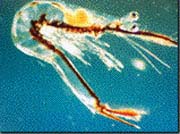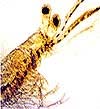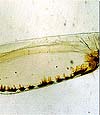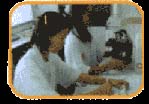Post larvae analysis – Introduction
PL QUALITY QUOTATION
 Assessment of quality of post larval shrimp is still widely regarded as skill that requires some experience to obtain. Many factors used in assessment are subjective and depend upon the preference and experience of the person assessing the post larvae. In the case of shrimp post larvae the small size makes this a relatively risky affair.
Assessment of quality of post larval shrimp is still widely regarded as skill that requires some experience to obtain. Many factors used in assessment are subjective and depend upon the preference and experience of the person assessing the post larvae. In the case of shrimp post larvae the small size makes this a relatively risky affair.
 To counter this and to provide a less subjective assessment, a programmer was carried out to investigate various way of determining PL quality. Initially this work was undertaken to give some idea of the effects of changes in the larval rearing methods (e.g., feed types, water exchange, chemical exposure, etc) on the quality of post larvae produced. Eventually, however, it was used as a way of assessing physical condition f post larvae before stocking in grow out ponds. In essence, the method is simple. By using a microscope, the physical appearance of post larvae is made more visible and easies to assess. Selection of a number of physical or morphological criteria separated into categories either as a straight choice (good versus bad) or by grading (good, acceptable, bad). There categories were assigned values allowing a score to be set for each post larvae examined. The individual scores could be pooled to give a score for the tank or batch of post larvae and this score related to target set by the examiner. The method also allows statistical analysis to be carried out and, by standardizing the categories to be tested and the scoring method, comparisons can be mad over time and between different examiner or labs. A large percentage of PL in sample showing obvious sings of deformity/ poor health or poor condition leads to a low score for the batch from which the sample is taken. However, absence of any obviously unfit PL merely indicates that the percent incidence is below a certain threshold, established by the sampling level used. The sample sizes and frequencies of post larval tanks may need to be sampled on any given day.
To counter this and to provide a less subjective assessment, a programmer was carried out to investigate various way of determining PL quality. Initially this work was undertaken to give some idea of the effects of changes in the larval rearing methods (e.g., feed types, water exchange, chemical exposure, etc) on the quality of post larvae produced. Eventually, however, it was used as a way of assessing physical condition f post larvae before stocking in grow out ponds. In essence, the method is simple. By using a microscope, the physical appearance of post larvae is made more visible and easies to assess. Selection of a number of physical or morphological criteria separated into categories either as a straight choice (good versus bad) or by grading (good, acceptable, bad). There categories were assigned values allowing a score to be set for each post larvae examined. The individual scores could be pooled to give a score for the tank or batch of post larvae and this score related to target set by the examiner. The method also allows statistical analysis to be carried out and, by standardizing the categories to be tested and the scoring method, comparisons can be mad over time and between different examiner or labs. A large percentage of PL in sample showing obvious sings of deformity/ poor health or poor condition leads to a low score for the batch from which the sample is taken. However, absence of any obviously unfit PL merely indicates that the percent incidence is below a certain threshold, established by the sampling level used. The sample sizes and frequencies of post larval tanks may need to be sampled on any given day.
 This manual is intended to give a guide to the morphological assessment developed to assess the quality of post larvae. It is not intended as a definitive guide to the ideal post larvae but as a standard method by which comparison of post larvae produced at different times and by different producers can be compared. The idea be hind the assessment is simple. The assessment was developed for use with post larvae of the black tiger prawn, Penaeus monodon, between the ages of PL 10 and PL 20. However, care was taken to establish the assessment using features which are non species specific so that it could apply to a wide range of penaeid post larvae with little or on further adaptation.
This manual is intended to give a guide to the morphological assessment developed to assess the quality of post larvae. It is not intended as a definitive guide to the ideal post larvae but as a standard method by which comparison of post larvae produced at different times and by different producers can be compared. The idea be hind the assessment is simple. The assessment was developed for use with post larvae of the black tiger prawn, Penaeus monodon, between the ages of PL 10 and PL 20. However, care was taken to establish the assessment using features which are non species specific so that it could apply to a wide range of penaeid post larvae with little or on further adaptation.
The assessment is made in two parts. The first stage is a gross inspection of the PL in the nursery tank. This is on different from the usual visual inspection made by nursery staff or potential buyers of PL. If the PL in the tank look bad or un healthy, then no microscopic analysis, whatever the result, will convince a buyer that the PL are good. Only PL which pass this first stage are sent on for further inspection in the lab. The second stage involves microscopic examination of a sup sample of PL, usually 15 or 25. This inspection allows a more detailed examination of apparently good PL (as assessed in stage 1) to identify any problems which cannot be soon easily in gross visual examination.
Microscopic examination
 The microscopic examination augments this assessment by studying a smaller sub sample of post larvae more rigorously. This helps to indicate quality related problems before they have progressed to a state sufficient to show up in the gross examination. For the hatchery, this provides a useful early warning so that corrective measures can be taken. For the farmer, it indicates that, although the post larvae appear on gross inspection to be of good quality, further assessment is required, greater care is necessary before during and after stocking the post larvae, or the post larvae should be rejected.
The microscopic examination augments this assessment by studying a smaller sub sample of post larvae more rigorously. This helps to indicate quality related problems before they have progressed to a state sufficient to show up in the gross examination. For the hatchery, this provides a useful early warning so that corrective measures can be taken. For the farmer, it indicates that, although the post larvae appear on gross inspection to be of good quality, further assessment is required, greater care is necessary before during and after stocking the post larvae, or the post larvae should be rejected.
.
.
.
.




